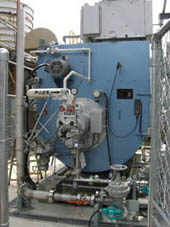New Kawasaki System Turns Waste Hydrogen into Boiler Fuel
Aug. 04, 2009

|
Tokyo, August 4, 2009 — Kawasaki Thermal Engineering Co., Ltd. announced today that it has developed a mixed combustion system for public utility supplied natural gas (which has been classified as “city gas” 13A in Japan) and waste hydrogen. The system makes controlling the combustion of waste hydrogen easier and more reliable than with conventional boiler combustion control systems. Waste hydrogen generated as a byproduct during chemical production processes can be used as boiler fuel. Since waste hydrogen generates no CO2 during combustion, demand is increasing for effective use of this byproduct as a way to reduce CO2 emissions. Conventional boiler systems using waste hydrogen mixed with natural gas as a fuel require the installation of measuring devices to monitor the amount of air and exhaust oxygen for combustion control purposes since the generation of waste hydrogen is unstable. Installation of these devices has always been a major stumbling block to making effective use of waste hydrogen a reality. This new combustion system leverages the technological expertise Kawasaki has gained over the years in combustion control of byproduct fuels. The system calculates the most optimal amount of air according to the inflow volume of city gas and waste hydrogen. This industry first is an innovative combustion system that makes effective use of waste hydrogen while eliminating the need to install any devices to measure air and exhaust oxygen volumes. The first smoke tube boiler equipped with this system has been delivered to Nankai Chemical Industry’s Kozaika Plant in Wakayama Prefecture, Japan. The system enables the plant to effectively use waste hydrogen that was previously released into the environment and save 1,090,000 m3N of natural gas, the equivalent of reducing CO2 emissions by 2,500 tons annually. System features (1)Equipped with both city gas combustion and city gas/waste hydrogen mixed combustion modes, the system maintains a continuous supply of steam even when a change in operations halts the generation of waste hydrogen. (2)The improved control logic enables the operator to easily switch from one combustion mode to another with the simple push of a button while the boiler is in operation regardless of the boiler load. (3)The system has a lower initial cost than conventional systems that require the installation of combustion control measuring instruments. (4)The system can be applied to smoke tube boilers as well as water tube boilers. Kawasaki will market the new system to boiler users who have given up using waste hydrogen as a boiler fuel and are merely releasing it into the atmosphere as well as those who have needed to add additional fossil fuel fired boilers to their operations. |





